

Aquarium snails are a popular form of algae eater and are loved by many aquarists. Mystery snails are one of the most common forms of pet snails in the aquarium hobby and are widely available at most pet stores. These are freshwater creatures that feed off green algae in the aquarium. Mystery snails are Gastropods and do well in tropical tanks with some patches of algae. They make great additions to community tanks and are very peaceful with fish and will not pose a risk to many species of fish.
Most aquarists will purchase a couple of mystery snails to tackle algae issues and to add some more life into their aquarium.
This is a complete guide on how to care for mystery snails and explore the benefits of adding a few to your aquarium.

Origins of Mystery Snails
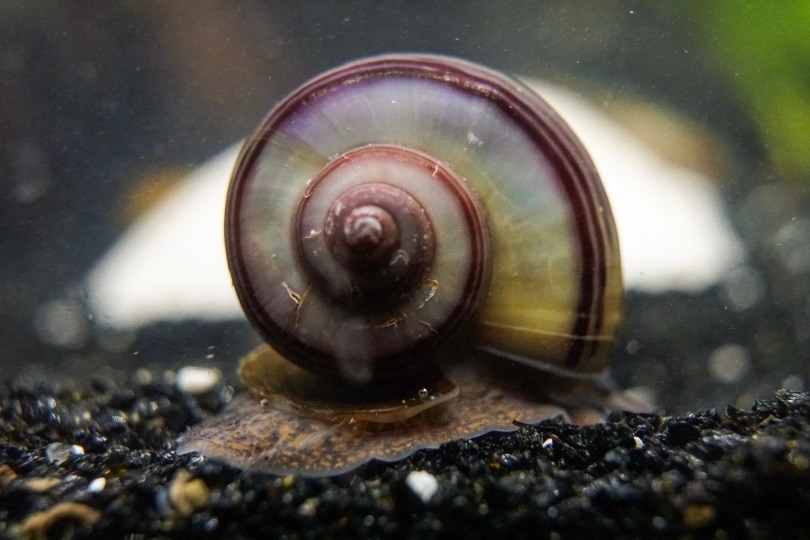
Mystery snails are also commonly referred to as apple snails or experts will use their scientific name, Pomacea bridgesii. These snails can live for up to a year in the wild but can live between one to three years in captivity. Mystery snails were originally brought to California for consumption purposes in 1892 and were slowly introduced into the aquarium trade. They originate from Asia and were found in Massachusetts back in 1915.
Mystery snails are also plentiful in the wild due to hobbyists illegally releasing them into the wild. This has led to large populations inhabiting water sources where they out-compete for indigenous wildlife.
These snails have complex eyes and mystery snails have no other sensory organs in their eyestalks. If the eyestalk was to be damaged, the mystery snail can grow it back over weeks.
Information Sheet
| Size: | 2-3 inches |
| Lifespan: | 1-3 years |
| Diet: | Omnivore |
| Family: | Ampullariid |
| Minimum tank size: | 10 gallons |
| Compatibility: | Community |
| Care level: | Easy |

Mystery Snail Appearance
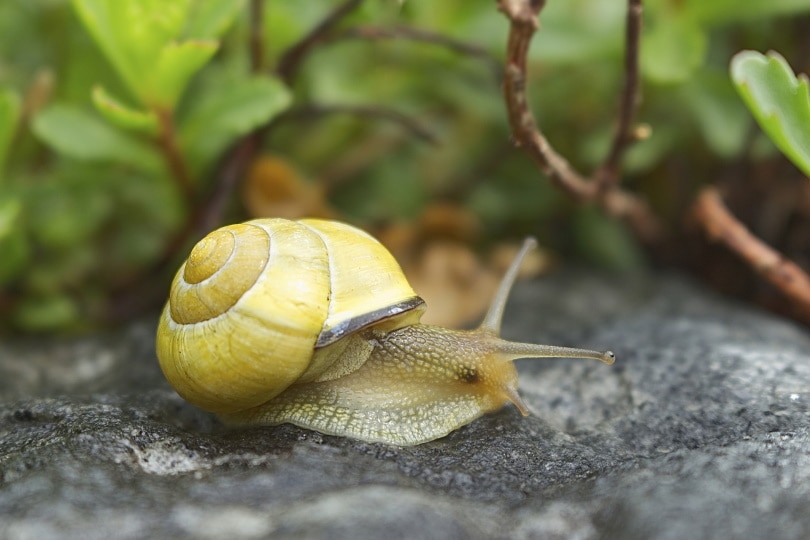
Mystery snails come in a variety of attractive colors. These colors are mainly described as golden, blue, purple, magenta, black, ivory, or hazelnut. There is no shortage of color choice with mystery snails which is why they are such a popular addition to many household aquariums. The shells come in banded, solid, or a gradient of color. The foot of the mystery snail is a large muscle that helps them move around the aquarium and can be a tan to black coloration. Some snails have a cream-colored foot and are commonly seen alongside the ivory shell coloration. The mystery snails have their apex on the side of their aperture and adults only have four whorls. Another interesting part of the mystery snails’ body is the operculum which acts as a shield at the front of their shell opening. This stops predators from reaching the more delicate parts of the snail.
The head of mystery snails has two tentacles that they use to search for food around the aquarium and directly above are their eyestalks, which help them to detect light and motion in their environment. Their eyesight is relatively poor, and they rely heavily on their sensory tentacles to make their way around the aquarium. Below the eyestalks in their mouth and a secondary pair of tentacles that help them during feeding. Mystery snail also has a siphon, which is an organ that they extend to pump oxygen from the surface and should not be mistaken with the genitals of the snail, which is tucked away behind the operculum. The siphon can stretch to nearly the full size of the snail and is used to help them pass water through their gills.
Signs of a Healthy Mystery Snail
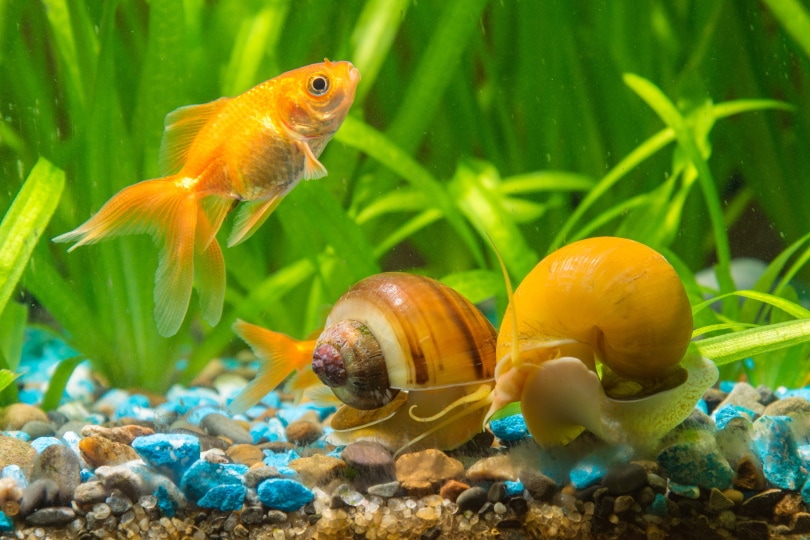
When purchasing a mystery snail from a pet store, you want to make sure they are healthy. Mystery snails are easy to care for, but they are not immune to poor health if the aquarium conditions are not right.
Here are some signs to look for to ensure that you are purchasing a healthy mystery snail, and not an empty shell:
- Heavy when picked up
- The body is not hanging limply out of the shell
- The snail can close inside of its shell
- The operculum is not damaged
- There is no erosion dots or patches on the shell
- The shell is smooth and dents free
- The snail retracts into the shell when held or poked
Mystery Snail Gender Identification
It is easy to determine the gender of golden mystery snails, as females will have a darker whorl, especially near the tip. Males will be lighter and have white genitalia on the right side of their bodies. This is only identifiable if you look at the snail from the inside when it is out of its shell. During mating season, the male may permanently carry their genitals on the outside of their tank.
Unlike many types of snails, mystery snails are not hermaphrodites and do not change gender. They are born either male or female and will develop separate reproductive systems.
This can be helpful when it comes to picking the same gender of snails for your aquarium to discourage breeding.
Minimum Tank Size
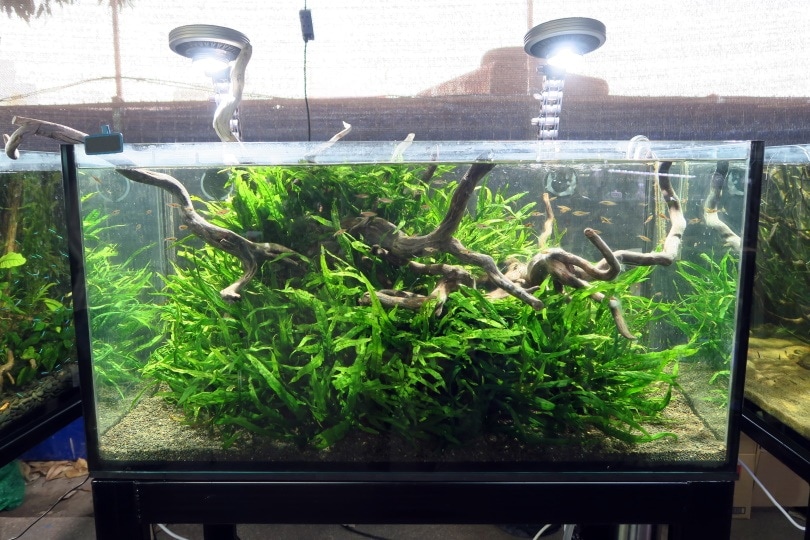
Mystery snails get large and can reach up to 3 inches in a standard aquarium. They are not suitable for bowls that are too small to accommodate their size. Bowls do not allow for the proper equipment to keep healthy mystery snails. It is best to stick to a minimum tank size of 10 gallons for every one to four mystery snails. If you want to keep more than four, a 20 gallon is recommended.
They should be kept in a standard rectangular tank that has both decent length and height. Mystery snails are active creatures that enjoy exploring a large amount of space in their environment. Large tanks will bring out the best of your mystery snail and ensures they are getting enough exercise to remain healthy.
Aside from being highly active, mystery snails are also messy and produce a huge bioload. They continuously pass waste inside the aquarium and can quickly foul up a small tank.
Below is a stocking guide for ADULT mystery snails:
- 10 gallon: 4 snails
- 15 gallon: 6 snails
- 20 gallon: 8 snails
- 29 gallon: 10 snails
- 40 gallon: 12 snails
- 55 gallon: 15 snails
- 75 gallon: 20 snails
- 100+ gallons: 25+ snails
By following that stocking guide, you will be able to keep the water parameters under control while giving your mystery snails their deserving space to roam.
Suitable Tank Conditions
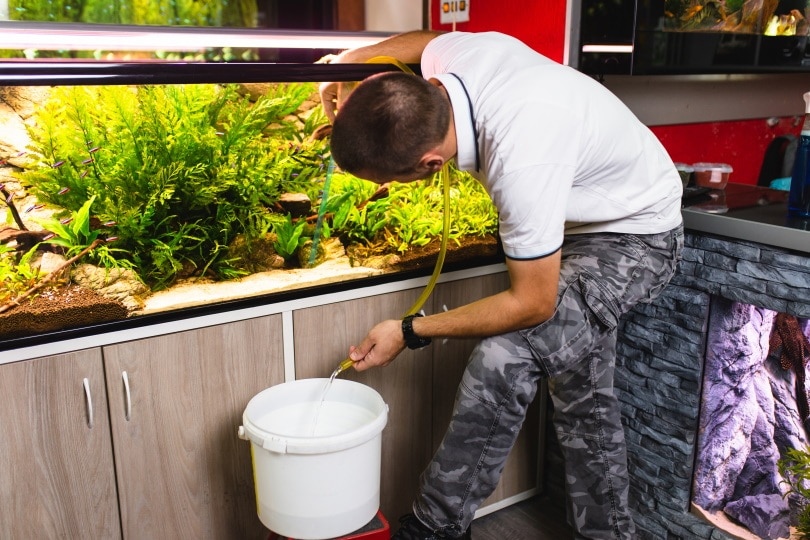
Mystery snails do not need specific conditions to remain healthy, but there are a few key requirements when it comes to keeping them healthy. Mystery snails are sensitive to fluctuations in temperature and water parameters. It is best to keep them in a tank that has a heater, they do not like the water too warm, and a required temperature range between 22°C to 26°C is recommended.
The water parameters should be frequently monitored by using a liquid testing kit. Ensure that the parameters stay between the following:
- Ammonia: 0ppm
- Nitrite: 0ppm
- Nitrate: >30ppm
Regular water changes should be conducted every week to replenish the tank with freshwater. Water changes will lower the nitrate concentration in the water and keep your mystery snail healthy.
Ideal Mystery Snail Tankmates
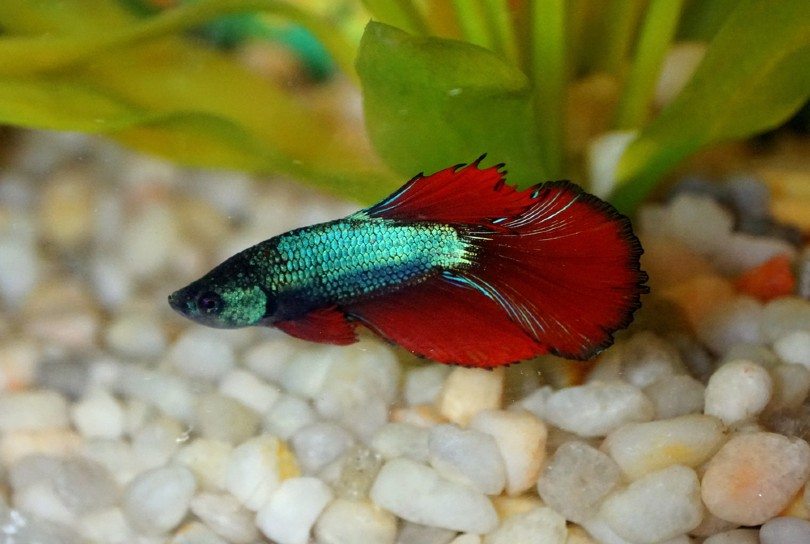
Since mystery snails are peaceful community fish, they can be housed with a variety of different fish. This is another reason they are such popular additions to freshwater tanks!
Mystery snail tankmates should be small enough to not fit a snail inside of their mouth. Larger fish will only see mystery snails as a quick food source and can potentially choke on their shell if the mystery snail is of a medium to large size.
Suitable tankmates:
- Betta fish
- Tetras
- Gourami’s
- Danios
- Red-tailed sharks
- Mollies
- Swordtails
- Platies
- Shrimp
- Angelfish
Mystery Snail Diet
Mystery snails are omnivores and consume plant matter and decaying fish or invertebrates in the wild. In captivity, they do well on a diet rich in both proteins and algae.
Although many aquarists think that a mystery snail will find all its food sources within the tank, this is not the case and can cause malnutrition and poor growth. This will shorten their lifespan and cause disproportionate growth. Many commercial foods are directed for mystery snails and you will only have to place food in the tank for these snails three to five times a week. Their diet should be plentiful with a lot of variety and enrichment to keep them healthy.
Mystery snails also benefit from fresh veggies that have been softened in boiling water. Carrots, cucumber, zucchini, boiled romaine lettuce, and other green leafy salads can be added to the tank for them to eat. Keep in mind this will quickly foul up the water and any leftovers should be removed using a net.
Safe commercial foods available at many aquatics retailers are algae wafers or sinking pellets, catfish sinking pellets, live plants, and many types of fish flakes.
Important- Mystery snails need boiled cuttlefish bone from the bird section of the pet store. The cuttlefish bone should be boiled and soaked for three days to get it to sink to the bottom of the tank. This is necessary for their shell health and they need high amounts of calcium to keep their shell and operculum in good shape.
Pro Care Tips
- Provide your mystery snail with logs, plants, and decorations to keep them occupied.
- Keep them with suitable tank mates and do not mix mystery snails with assassin snails.
- Do not medicate the tank with anything other than dechlorinate as fish medications are deadly to invertebrates.
- Make sure the mystery snails’ tank is cycled before placing them inside.
- Supplement their diet with calcium-rich foods and liquid calcium.
- Keep the water line filled to the top of the tank to discourage unwanted breeding.
- Use a soft substrate so they do not injure themselves when they slide over it.
- Use a dechlorinate that removes heavy metals from the water column as dissolved metals are toxic to invertebrates and fish.
Breeding and Egg Help
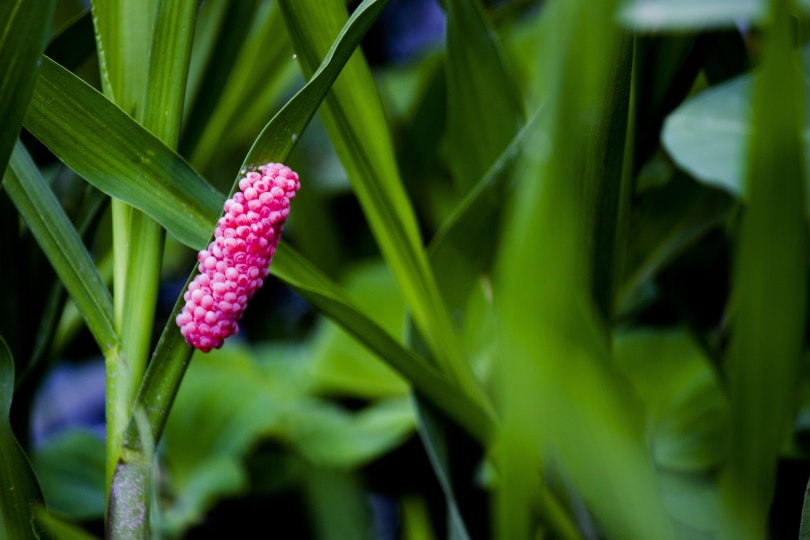
It is no secret that mystery snails have the reputation to quickly overpopulate the tank with their rapid reproducing rate. Mystery snails will breed in a variety of conditions and this can be a problem for aquarists who do not want a high population of snails in their tank.
Mystery snails breed when the temperature increases and food becomes plentiful. If the water level is low which encourages breeding, they may take to laying their cluster of eggs along the rim of the tank or even underneath a hood or canopy. They will usually mate once they have reached their adult stage and mating can be stressful for the females. The male mystery snail will usually mount a female even if she is unwilling to mate. The female will then attempt to throw him off by moving their shell back and forth. If this is commonly occurring in your tank, you may have to move the males to a separate tank for a few days to give the female a break. If a female is over-mated, she can also suffer from a prolapse which is fatal.
If you do not want your mystery snails to breed, it is best to keep the same gender in your tank.
The eggs will look like a cluster of light pink balls bunched together from the hood of the tank or just below the waterline. The eggs can be removed and placed in a container of wet paper towels if you plan to hatch and grow out the babies. Mystery snails lay hundreds of eggs, which means you will be dealing with a lot of babies. A mystery snail nursery can be set up with a 10-gallon tank, filter, heater, and aeration system. The young snails will require a lot of food and high amounts of calcium to grow their shells.
Wrapping it Up
Mystery snails are fascinating and intricate pets that are not only great for beginners but also fit into many standard tropical tanks. They are entertaining to watch and some mystery snails have been known to eat out of their owner’s hands. Raising mystery snails is a fun way to start your aquatic invertebrate journey and expand your aquarium knowledge!
We hope this guide has helped inform you on all the interesting care aspects of mystery snails.
Featured Image Credit: MHawkinson, Shutterstock
Nicole is the proud mom of Baby, a Burmese cat and Rosa, a New Zealand Huntaway. A Canadian expat, Nicole now lives on a lush forest property with her Kiwi husband in New Zealand. She has a strong love for all animals of all shapes and sizes (and particularly loves a good interspecies friendship) and wants to share her animal knowledge and other experts’ knowledge with pet lovers across the globe.






